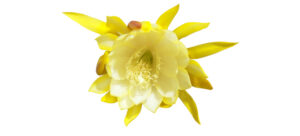
The Queen of the Night Flower, also known as the Night Blooming Cereus, is a unique and mysterious plant. This flowering cactus is famous for its large, fragrant white flowers that bloom for just one night each year. This flower's petals are a stunning white, resembling moonlight, and its center glows with a soft yellow hue.
The flower of this blooming cactus opens after sunset and closes at dawn, creating an enchanting spectacle. This brief blooming period adds to its allure, making it a highly anticipated event for plant enthusiasts.
Mature plants grow up to 10 feet tall when grown outdoors but are usually much smaller when grown indoors. This is a tropical succulent genus often called climbing cacti or orchid cactus.
In the wild, the Queen of the Night often grows as an epiphyte, which means it lives on other plants, usually trees, without harming them.
What Is The Origin Of The Queen of the Night Flower
Also known as the Queen of the Night Catus, this cactus with flowers has its origins in the arid deserts of Mexico, the American Southwest, Central America, and South America. This remarkable plant is a member of the cactus family, uniquely adapted to thrive in harsh, dry environments.
Its most notable feature, the nocturnal blooming pattern, evolved as a clever adaptation to attract pollinators active at night, like moths and bats. The flower's stunning, large white petals and sweet fragrance are nature's way of ensuring pollination in a landscape where daytime pollinators are scarce.
Other Names For The Queen Of The Night Flower
- Night Blooming Cereus – This is the most common alternative name, emphasizing its characteristic of blooming at night.
- Epiphyllum Oxypetalum – This is the botanical name for one of the species commonly referred to as the Queen of the Night.
- Dutchman's Pipe Cactus – A name that highlights the pipe-like shape of its flowers.
- Lady of the Night Flower – Another name that reflects its nocturnal blooming nature.
- Princess of the Night – A variation of its more regal title, emphasizing its majestic appearance.
Queen of the Night Flower Care
Caring for the Night Blooming Cereus, a type of night-blooming cactus, involves a few key steps to ensure it thrives:
Light
Provide bright, indirect sunlight. Too much direct sunlight can burn the leaves, while too little can hinder growth and blooming.
Soil
Use a well-draining soil mix, ideally formulated for cacti and succulents.
Water
Water thoroughly, but only when the soil is dry to the touch. Over watering can lead to root rot, which is a common issue with cacti and succulents.
Temperature and Humidity
Keep in a warm environment; it prefers temperatures between 50-70 Degrees Fahrenheit. Avoid exposing it to temperatures below 50°F. Average room humidity is fine. If your home is dry, misting can help.
Fertilizing
During the growing season (spring and summer months), fertilize monthly with a balanced, water-soluble fertilizer, diluted to half the recommended strength.
Pruning
Prune sparingly to remove dead or damaged segments and to shape the plant if desired.
Potting or Repotting The Queen of the Night Flower
When potting or repotting the Queen of the Night Cactus, it's crucial to follow specific steps to ensure the health and growth of the plant. This process typically requires attention to detail and a bit of gardening know-how.
Choosing the Right Pot For The Queen of the Night Flower:
Select a pot with adequate drainage holes to prevent waterlogging. The new pot should be slightly larger than the current one, allowing room for growth without being excessively spacious.
Soil Selection:
Use a well-draining soil mix, ideally formulated for cacti and succulents.
Preparing the Plant:
Before repotting, water the plant a few days in advance. Carefully remove the plant from its current pot, gently shaking off excess soil and inspecting the roots for signs of rot or disease.
Potting the Plant:
Place a layer of soil in the bottom of the new pot. Position the plant in the center, ensuring it's at the same depth as it was in the previous pot. Fill in around the plant with soil, gently tamping down to eliminate air pockets.
Watering After Potting:
After repotting, wait a few days before watering to allow any damaged roots to heal. This reduces the risk of root rot.
Queen of the Night Flower Aftercare:
Place the pot in a location with bright, indirect light and resume regular care. Monitor the plant for signs of stress and adjust care as needed.
Repotting is done in the spring or early summer, which aligns with the plant's natural growth cycle. Although not an annual necessity, repotting is recommended when the plant outgrows it’s pot or the soil becomes compacted.
Common Pests, Diseases, and Problems for Queen of the Night Flower
The Queen of the Night Flower can face several common problems, but with proper care, these issues can be managed or prevented.
Under watering:
If the leaves wrinkle, it suggests under watering. Increase watering frequency, ensuring the soil is completely dry between waterings.
Over watering:
Over watering can often lead to root rot. Leaves may appear mushy or discolored. Allow soil to dry out completely before watering again and ensure good drainage.
Insufficient Light:
Lack of light can cause leggy growth or lack of flowering. Solution: Place in a location with bright, indirect sunlight.
Pests:
Mealybugs and spider mites are common. Using insecticidal soap often helps.
Temperature Stress:
Extreme temperatures can damage the plant. Keep the plant in a temperature range of 50-70°F.
Fertilizer Burn:
Over-fertilization can harm the roots. Solution: Use a diluted, balanced fertilizer and apply sparingly.
Regular monitoring and modifying care routines, as needed, will keep your Queen of the Night healthy and thriving.
Final Thoughts About The Queen of the Night Flower
Although these plants flower open only at night once per year, it's well worth the time and effort to see.
Need help? Call us at 888-815-9763 to speak with a staff member today!









